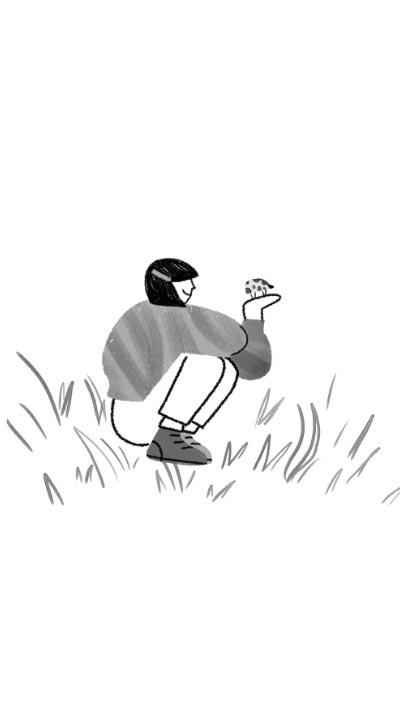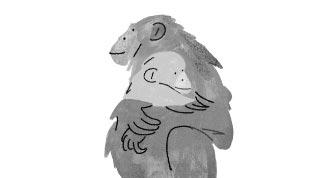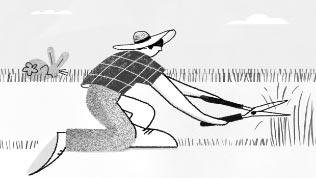A child's eye view
by Henry Mance
Children love animals. So what goes wrong?
I'm not sure when I first had the urge to adopt chickens. It certainly wasn't while I was near any of them. But one thunderous summer's afternoon, I found myself driving my young daughters and a cardboard box to pick up two laying hens who had reached the end of their commercially productive lives.
This was an opportunity to rescue two sentient beings from a premature end. And it was more than that - a chance for my children to understand that eggs come from animals, not supermarkets. Plus, with coronavirus restrictions set to stretch for months, I thought we could all use as much non-human company as we could find.
I did my research. I learned about bedding and parasites and bought an expensive coop. Sadly, I did not learn about the size of chickens' feet. Huge! Dinosauresque! When we arrived home, one of us needed to lift the hens out of their cardboard box and gently onto the ground so that their fragile bones didn't break. I decided it couldn't be me.
'You could have mentioned you were scared of chickens,' my wife Susie said, rolling her eyes.
One of the chickens, named Kakiyaki by my daughters, was poorly on arrival, and, sadly, did not survive long. The other, Patilda, came to dominate the garden. Her feathers grew back. She delighted in dustbathing, rushing around the shrubs, tapping at the windows. My daughters had hoped she would provide eggs. Quite quickly, they settled for just not being pecked.
Then Patilda started hiding in the garden. I was careless. A fox took full advantage. I had wanted to talk to my children about eggs. I found myself talking to them about the other end of life.
We love animals. It's been established that 43 percent of adult Britons believe that animal lives matter at least as much as human lives, and the proportion is higher among those aged 18 to 24. Most UK households now have a pet. Many families sit down to watch Attenborough documentaries. We surround young kids with amazing numbers of imaginary animals: storybooks, teddy bears and Peppa Pig.
But where does this love lead us? In late-19th-century Britain, many parents wanted their children to care for animals on the basis that it would prepare them to be kind to people. Our perspective has changed, for the better. Caring for animals is now seen as valuable in itself, because animals have feelings. Many of us treat the companionship of animals not as a stepping-stone to better treatment of other people, but as an integral part of a good life. Understanding animals is also a key part of addressing the climate and biodiversity crises.
Even so, we haven't quite got it right. We have not bridged the abyss that now often separates us from the natural world. We learn to love animals without taking on board the behaviours required to do best by them. Most children grow up without an ethic of stewardship for animals beyond taking care of the family dog or cat. And even the best parenting books don't tell parents how to foster such an ethic.
This is a huge, missed opportunity because childhood is when we are at our most malleable. Our expectations are formed, as are our appetites. That matters, because, for environmental reasons as well as for animal welfare, we urgently need to eat less meat and dairy.
The good news is that children start off extraordinarily sensitive to animals. Given a choice between playing with a hamster, a doll or a toy aeroplane, toddlers will tend to choose the hamster. Animal sounds are among their first words.
There is some evidence that children attach greater value to animal lives than do adults. Psychology researchers asked a group of American adults whether, faced with the choice, they would save the lives of 100 dogs or one human. A large majority chose to save the human. But when the researchers asked a group of children aged five to seven, a large majority chose the dogs. Such a direct trade-off might seem distasteful, and I personally would struggle to put a human life behind a non-human life. But as an indication of children's sensibilities, it is intriguing.
Children seem to relate to animals more strongly. They are curious about creatures that adults take for granted - spiders, slugs, gulls. To children, ladybirds can be as exciting as lions - after all, ladybirds can fly and don't bite, and a lion won't sit on your finger. The risk is that as children enter their teens, they lose this connection with animals. They take on the habits of previous generations.
How can we instead make the most of their early fascination? There are three areas where we could easily do better.
The first is to impress on children the reality of sentience. When I was a child, I was warned away from anthropomorphising animals. Disney films were dismissed on the basis that they were too sentimental. But, as the primate expert Frans de Waal has argued, in general it is less risky to anthropomorphise than not to anthropomorphise.
Scientists' understanding of the mental and social lives of other animals has advanced enormously. As far as many mammals and birds are concerned, we can assume that they may share some of the same emotions that we have, and that they will benefit from being able to make decisions that affect their own lives.
With my children, I try to refer to animals (including insects and fish) as 'he' or 'she', rather than 'it'. And I try to nudge them to guess at how the animal might view the world. When taking a dog for a walk, we can be tempted to pull on the lead. But it's the dog's walk, and where possible they should have the freedom to decide the pace, the route and the detours.
Taking animal sentience seriously has also changed my view of zoos. I grew up loving London Zoo, and I assumed the animals were happy there. But it's not enough for animals to have their physical needs satisfied. They also benefit from having autonomy over their movements and social relationships. Many animals, particularly larger ones such as elephants, can't do this in zoos. There isn't the space, the populations aren't large enough and herds cannot form naturally.
For almost two centuries, zoos - and, until recently, circuses - have been a major way in which children have discovered exotic animals. But we should look for other contexts, where animals are living freely. I have avoided taking my children to zoos. I prefer good farm parks. Mostly I try to show my children the beauty of wild animals, like frogs and crows.
This leads to the second area where we could do better. Our children have so much to gain from contact with nature, which reveals and exposes our connection with other animals, our shared past and future. But right now we are losing touch. Children spend as much time outdoors as some prison inmates. The Oxford Junior Dictionary has removed the names of species that children living in cities and playing online no longer encounter. Front gardens are paved, back gardens are covered in Astroturf.
In their book The nature seed, the writer Lucy Jones and park manager Kenneth Greenway say that children 'require a meaningful connection with the rest of nature in their everyday lives - not just as an occasional add-on'. This means the freedom to go outdoors safely, which in turn requires our streets and communities to be differently designed. Such large and systemic improvements to the urban landscape are beyond any one adult's control.
In the meantime, we can try not to worry about dirty or wet clothes. Exploring the outdoors is worth the dirt and mess. We can try to rekindle our own childlike excitement at nature. In her 1956 essay, Help your child to wonder, the biologist Rachel Carson wrote: "One way to open your eyes to unnoticed beauty is to ask yourself, 'What if I had never seen this before? What if I knew I would never see it again?' "
Carson argued that for parents seeking to guide their children, 'it is not half so important to know as to feel'. That chimes with my own experience. Recently my five-year-old daughter declared that, if she were to be another animal, she would like to be a dolphin. I attempted to turn this into an educational opportunity.
'Are dolphins fish?' I asked her.
'No.'
'That's right. What are they?'
'They're dolphins.'
It was a reminder that kids don't necessarily need to categorise animals to feel empathy for them (although if they do want the names of species that they see out on walks, an app like iNaturalist will help).
The third, and thorniest, area is food. Peter Singer, the Australian philosopher, wrote nearly 50 years ago that 'we never make a conscious, informed decision, free from the bias that accompanies any long-established habit, reinforced by all the pressures of social conformity, to eat animal flesh'.
His words remain true today. At a recent exhibition about Paddington Bear's journey from Peru, children were asked what they would put in their suitcase for a long journey. One eight-year-old had drawn his two choices: a hamburger and hot dog, 'to eat if I'm hungry', and his pet fish, 'if I want to play'. He inadvertently summed up our mixed expectations of animals.
Having seen the meat industry up close, I don't eat animal products. I believe that veganism is the logical conclusion of the love for animals we learn in childhood. But even many meat-eaters accept that we need to eat less meat and dairy to reduce our carbon emissions; and because the rise of cheap chicken, in particular, has been built on poor welfare. Henry Dimbleby's National Food Strategy proposed a 30 percent cut in meat consumption by 2030.
We are, though, raising our kids to eat roughly as much meat as we do, mostly without asking where it came from. In England, unless they opt out, schoolchildren will be served meat or poultry at least three times a week. They can also be served burgers, sausages or chicken nuggets once a week at primary level or twice a week at secondary. Even vegetarian parents sometimes step back from raising their children without meat, worried about nutrition and social isolation.
I think schools should be leading the shift to offering children high-welfare meat, less often. They should create more opportunities for parents and children to opt into meat dishes rather than opt out. Schools can encourage pupils to have one meat-free day a week, which still falls far short of the change we need.
When the RSPCA emerged, the political debate centred on widespread, visible cruelty to animals: the beating of sick horses in the street or the baiting of bulls for entertainment. Huge progress has been made, and having a loved family pet, as many families do, surely helps ward our children against the worst forms of cruelty.
Today, one major challenge is thoughtlessness. Children may lobby for French bulldogs, pugs and other unhealthy breeds of dogs. They may feel no connection with the factory chicken farms or the worn-out dairy cows on which their school dinners may rely.
When we teach our children about animals, we also teach ourselves. Parenthood is a chance for adults to rethink how we live. The arrival of imaginary animals in my home after my daughters were born rekindled my own childhood love for other species. There is no right answer to the question of how to treat animals. Our standards will, hopefully, continue to increase. And I look forward to my children challenging me on the question of how we care for our pet cat or deal with pests in the garden (though of course, all parents must resign themselves to their children rebelling and I suppose one day my children may decide that they love steaks and hate nature walks).
To love animals is to see sadness and injustice. In my children's lifetimes, animal cruelty will take new forms. Some species will become extinct, as a result of a loss of forests and grasslands. Many wild animals will struggle to adapt to climate change and extreme weather events like floods and wildfires. My hope is that, by passing on an ethical belief that we should treat animals well, I will at least give my children a feeling that they are part of the solution - that they are repaying some of the joy that animals have given them.
Rachel Carson is an inspiration here. She saw beauty everywhere she looked in the natural world. When she was dying of cancer in her mid-50s, she found consolation in the migration of monarch butterflies, many of whom never return. She wrote to a friend: 'it is a natural and not unhappy thing that a life comes to an end. That is what those brightly fluttering bits of life taught me this morning'. The more we can see parallels between our lives and the lives of other animals, the more likely we are to treat them with respect.
In hindsight, adopting chickens was not one of my more successful attempts to teach my children about animals. But we gave Patilda at least some weeks of happy retirement. We still have one of her feathers in the kitchen, and I hope that the memory of her running around the garden will stay with my daughters. It was so clear to us all that Patilda had a personality of her own, that her life was valuable on its own terms. If that is our starting point, we are likely to end up a more compassionate society.

Henry Mance
Henry Mance is the chief features writer at the Financial Times. He is the author of How to love animals and protect our planet, a book that outlines an ethic for living in harmony with other species.

Dave Allen
Head of Prevention and Education
Henry Mance's essay addresses one of the core missions of the RSPCA - our role in promoting kindness and preventing cruelty through our animal welfare messages designed for younger audiences. Our strategy recognises that this is how we will grow a more compassionate generation and ultimately reduce demand for intervention from our inspectors in the future.
We have a plethora of education programmes tailored to meet the needs of each individual young person, whether they're looked-after children, those who have harmed animals in the past, those who are struggling with mental health issues, or just schoolchildren in a standard education setting.
One of the young people we've helped through these programmes is Amy, who was struggling in school and always in trouble. She joined one of our 6-week programmes and after a hesitant start, grew in confidence and began to see why the science and literacy she had to study in school was important. Her behaviour improved and she was allowed time out of lessons to work on a care farm. Here she carried out a first aid check on a piglet, which she had been taught to do on the RSPCA course. She discovered an infection and reported it to the livestock manager who was impressed and allowed her to give the medication and monitor the pig's improvement. She wrote a report about her RSPCA course and the incident at the farm and this was commended by the headmaster of her school - her first piece of positive recognition.



